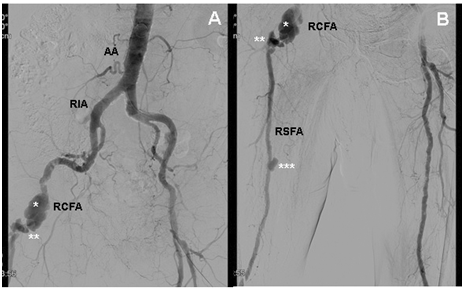eISSN: 2378-315X


Case Report Special Issue Global Health & Infectious Diseases
Internal Medicine Department, University Hospital Marquésde Valdecilla, Spain
Correspondence: Cardiovascular Surgery Department, University Hospital of Salamanca, Spain, Tel 923291263
Received: April 09, 2018 | Published: September 19, 2018
Citation: Arnáiz-García AM, Pérez-Canga JL, Arnáiz-García ME. Multiple mycotic femoral aneurysms in the background of a hidden endocarditis as cause of intermittent bacteremia. Biom Biostat Int J. 2018;7(5):419-420. DOI: 10.15406/bbij.2018.07.00240
The term intermittent bacteremia is applied in those cases which the patient remains febrile in despite establishing the specific antibiotic treatment and in the presence of negative blood cultures. Its causes are variable and its presence should make us suspect a hidden infection. The appearance of mycotic aneurysms in the context of an infectious endocarditis is very infrequent. The presence of mycotic aneurysms as a cause of intermittent bacteremia is exceptional. We present the case of a patient diagnosed with intermittent bacteremia in the context of mycotic aneurysms secondary to native aortic valve endocarditis, as well as its complete management and treatment.
Keywords: fibrillation, broad-spectrum, focality, Ceftaroline, ultrasound, limbs, transesophageal
The diagnosis of intermittent bacteremia is made when it occurs after the establishment of an appropriate antimicrobial treatment for which the isolated microorganism is sensitive, and the blood cultures are already negative. Inadequate concentration of the antimicrobial in blood, the presence of an endocarditis, an endovascular infection or hidden infectious focus have been suggested as its main causes. The presence of mycotic aneurysms in the context of an infectious endocarditis is infrequent, and its presence at the infrainguinal level is exceptional. Herein, we present a 82-year-old man with a previous history of hypertension. He was diagnosed of a mild aortic stenosis and permanent atrial fibrillation, and he was admitted to the Emergency Department due to fever and malaise of fifteen days of evolution. The physical examination did not show relevant findings, but the routine analysis showed severe leukocytosis, with elevated PCR and procalcitonin. With no apparent infectious focality, blood cultures were requested, and broad-spectrum empirical antibiotic therapy was initiated with Meropenem 1gr/8h+Linezolid 600mg/12h. The blood cultures were rapidly positive for methicillin-sensitive Staphylococcus aureus, and the antibiotic treatment was de-escalated to Cloxacillin 2gr/4h iv. Given the previous history of valvular heart disease, a transesophageal echocardiogram was requested, ruling out an endocarditis. However, in spite of the specific antibiotic treatment, episodes of bacteremia persisted. The antibiotic treatment was extended to Daptomycin 750mg/24h+Ceftaroline 600 mg/12h and with the diagnosis of intermittent bacteremia, the transesophageal echocardiography was repeated twice more, resulting in a negative result. However, progressively, purpuric lesions appeared in the right lower extremity that evolved to ulcers. Doppler ultrasound of the lower limbs was performed, compatible with a popliteal deep venous thrombosis. A Gallium-67 scan was requested, which detected multiple hypercaptator foci in the right gluteal and inguinal regions, compatible with septic emboli. The transesophageal echocardiography was repeated again, although it did not show aortic vegetations, it did detect the presence of severe aortic insufficiency not present in previous studies, which confirmed the infectious valvular dysfunction. Given the age and functional deterioration of the patient, conservative treatment was decided and he was discharged asymptomatically after 6 weeks of antibiotic treatment with Daptomycin and Ceftaroline. Two weeks later, the patient was admitted due to coldness and worsening of the right injuries. In the presence of signs of distal ischemia, an arteriography was requested showing two lobulated aneurysms at the level of the common femoral artery, as well as an aneurysm in the superficial femoral artery at the level of the thigh Figure 1, all of which were compatible with mycotic aneurysms. Quickly antibiotic treatment with Daptomycin 750mg/24h iv + Piperacillin-Tazobactam 4gr-0.5gr/8h iv was established. Given the risk of loss of the right extremity, surgical treatment with femoral reconstruction from iliofemoral to deep femoral junction and femoropopliteal bypass with homograft was decided. After two weeks of antibiotic treatment, the patient was discharged home afebrile and asymptomatic. Bacteremia is defined as the presence of bacteria in the blood. It is related to a high morbi-mortality, so the correct identification of the microorganism as well as its focus will be crucial to achieve optimal management.1–2 The term "intermittent" bacteremia is applied in those cases in which bacteremia persists despite the establishment of specific antibiotic treatment for the microorganism previously identified, and in the presence of negative blood cultures. An incorrect concentration of the antimicrobial agent, an unknown resistance to it, an immune alteration in the host, or the presence of hidden infectious foci, such as endocarditis or an unknown intravascular focus are usually its main causes and should be the main reason for suspicion.1–2 The appearance of mycotic aneurysms in the context of an infectious endocarditis is very infrequent (1.1%),3 being exceptional at an infrainguinal level. The presence of distal ischemic lesions in the presence of bacteremia or endocarditis, should make us suspect its presence. Its treatment includes resection or isolation of the aneurysm and revascularization of the affected limb with autologous or heterologous biological vascular grafts (homografts), always associating prolonged antibiotic treatment to reduce the risk of infection.3–4

None.
The author declares there is no conflict of intrest.

©2018 Arnáiz-García, et al. This is an open access article distributed under the terms of the, which permits unrestricted use, distribution, and build upon your work non-commercially.
2 7